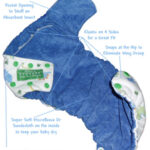When my daughter was first born, she was a little bundle of peaches and cream with a shock of red hair that made me grin. Within weeks, it was obvious that she also had hypersensitivity to many things. She needed hypoallergenic formula, and had to use either cloth or herbal disposable diapers. I learned quickly how to spot the beginning of a diaper rash and work quickly to treat it, or it would result in something so severe it looked blistered.
First and most important: If the rash is so bad it looks blistered and you are breast-feeding, you should double-check with a doctor to make sure that the rash isn’t actually a yeast infection caused by the sugar in your milk, or thrush. Also, if the diaper rash doesn’t clear up in 3-5 days, ask your doctor about possible food allergies because these can cause symptoms that look a lot like diaper rash.
Identifying Diaper Rash
When you see diaper rash for the first time, it is pretty obvious what you’re dealing with. Diaper rash usually occurs at least once during a child’s first 3 years of life, but most often happens before they’re a year old. It appears as a red layer, or red blotches, on the skin under the diaper area.
Usually, the first sign of diaper rash will be red, irritated skin on your baby’s bottom or genital area. If not treated, it will spread from there and can become extremely bad in the folds of baby’s legs where the diaper is tightest.
Diaper Rash Causes
There are many things which can cause diaper rash, but most of the causes of true diaper rash – not a yeast infection – are related to the diaper itself.
When your baby’s skin is being rubbed by wet diapers, a red, shiny rash will appear. This irritation can also be caused by the cleansers you’re using to wipe baby down when changing their diaper. Both of these causes will generally be seen in the area where the diaper rubs, and not in the folds of baby’s legs.
Another, less common cause for diaper rashes is an allergic reaction. This allergy could be to the diaper wipes, diapers, laundry soap, bath soap, or lotions you’re using. Be aware that this applies to what lotions and soaps you use on yourself, as well as baby. Lotion applied to your hands will transfer to baby’s skin when you hold them.
Treating Diaper Rash at Home
Usually, a diaper rash won’t require medical attention. Taking good care of baby’s skin is the best treatment for diaper rash, and these steps will help the rash clear up in just a couple of days:
1. Carefully wash your hands with a very mild soap both before and after you change your baby’s diaper. This helps prevent the spread of rash or any other infections.
2. Change baby’s diaper more often than usual. The moment you feel wetness, it’s time for a new diaper. Using cloth diapers makes this much easier, as disposable diapers can hide the wetness.
3. With each diaper change, wash your baby’s skin with a very mild soap – do not scrub, or you could cause more irritation – and allowed to air dry. Leave the diaper off for at least an hour, if possible, to give the sensitive skin time to heal. If it’s not possible to leave the diaper off, gently pat the area dry before putting on a new diaper.
4. Avoid plastic pants or diaper covers during this time. The skin needs to be exposed to as much air as possible.
5. Once the rash has cleared, prevent a new rash by continuing to wash your hands before and after diaper changes, and allowing your baby’s bottom to get as much air time as possible. A thin layer of corn starch or baby powder can also help by preventing baby’s skin from coming into contact with waste.
Seeking Medical Care for Diaper Rash
Simple diaper rash, no matter how severe, doesn’t usually require a visit to the doctor. Keeping the area clean, dry, and exposing it to air as much as possible with both treat and prevent most diaper rashes.
It’s important that you keep an eye on the rash, though, because some infections start out looking so much like diaper rash that you won’t know the difference until it’s become a problem. When should you call the doctor?
1. If the rash doesn’t get better after 4-7 days of home treatment, or if it begins to spread to other parts of the body.
2. If the rash develops a yellowish crust or starts to seep, it is likely impetigo and will need to be treated with antibiotics.
3. If the rash is accompanied by diarrhea that lasts for more than 36 hours, or if the your baby starts to show signs of severe pain or a fever.





